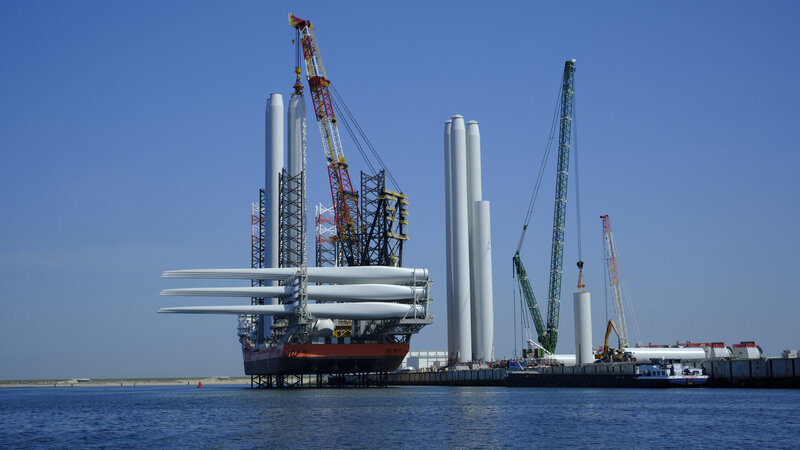The EU wants to scale up domestic production of renewable gas. By 2030, the EU should produce 10 million tonnes of green hydrogen and 35 billion cubic metres of biomethane. This equals a 20% renewable gas market share of total gas consumption.1 Achieving this requires investments in 65-80 GW electrolyser capacity and about 40 GW biomethane capacity at a capital cost of 150-250 billion euro.2 Getting these investments planned, financed, permitted, built and grid-connected is a huge task. It can easily take six years or more for projects to materialise. The Dutch experience in scaling up offshore wind offers a powerful example on how to get it done.
The first offshore wind park off the coast of the Netherlands became operational in 2007, followed by a second project in 2008.3 During the seven years thereafter no new wind parks were built. No clear legal framework existed and no stable support scheme. Subsequent governments set different policy goals and modified subsidy schemes. Also, wind developers were responsible for site selection, for performing environmental impact assessments and for applying for permits. This led to high costs and project risk because of the high uncertainty whether a project would be approved and financed. Dozens of applications during this phase got rejected.4
In November 2012, a new government took office. It was led by Mark Rutte in a coalition with PvdA, the Dutch labour party led by Diederik Samsom with a clear climate and renewables agenda.5 This government would shake up Dutch offshore wind policy.
The new government set up a system for tendering standardised lots of capacity (currently 700 MW each) combined with permits and guaranteed grid-connection. The government decided to identify designated areas for offshore wind and perform environmental impact assessment studies themselves. Detailed tender criteria were issued, including ecological criteria. Initially, a feed-in premium was part of the package too, yet the new approach led to the world first subsidy-free offshore wind project in 2018.6 By 2031, the Netherlands will have 21 GW offshore wind capacity.
Lessons can be taken from this successful policy to speed up investments in biomethane plants and electrolysers. National governments can take the lead in planning a steady increase in renewable gas production capacity over the next eight years. Governments would identify suitable areas for biomethane and green hydrogen, based on the availability of biomass feedstock and (future) renewable electricity production respectively as well as closeness to gas and hydrogen infrastructure, including (where applicable) landing points of offshore wind. Also, governments would decide on the desired production capacities within these areas, and take care of environmental impact assessments.
Following this, ‘package deals’ are tendered, consisting of the right to construct a certain capacity at a certain location or within a zone, permits and grid access included; possibly combined with investment subsidy. This offers significant benefits to investors and project developers and would offer clarity to TSOs and DSOs for their network and investment planning. Also, governments performing environmental impact assessments rather than developers can avoid and limit the need for appeal procedures. All of this still leaves sufficient initiative for investors and a competitive marketplace.
When I discussed this concept with a project developer, he responded that ‘this sounds like heaven’. That may be overstating the impact, yet ensuring a much more rapid ramp up of renewable gas production would already be quite something.
1 In addition to this, REPowerEU includes a target for 10 mln tonnes of green hydrogen imports from outside the EU. This would constitute another 10% of total gas consumption by 2030, leading to a total share of 30% renewable gas in total EU gas consumption.
2 The targets for domestic EU green hydrogen and biomethane production are similar in size: 330 TWh of green hydrogen and 370 TWh of annual biomethane production, of which 40 TWh of biomethane is already produced today. Hydrogen capacity estimate assumes a 47 to 57% capacity factor for electrolysers; biomethane capacity assumes 90% utilisation. Investment cost estimate assumes €1500 to €2000 per KW of electrolyser capacity and a similar amount for integrated biogas-biomethane production capacity. Total biomethane investment costs can be lower if part of the existing 16 bcm (170 TWh) of non-upgraded biogas gets upgraded to biomethane. On top of investments in production capacity, additional investments are needed to create hydrogen transport infrastructure and to connect biomethane plants to existing gas grids.
3 In 2007 ‘Noordzeewind’ became operational (108 MW); followed by ‘Prinses Amalia’ in 2008 (120 MW). The next project, 129MW ‘Luchterduinen’, followed only in 2015.
4 RVO, Dutch offshore wind manual (2022), p.9.
5 With Frans Timmermans as Minister of Foreign Affairs
6 Built by Vattenfall
